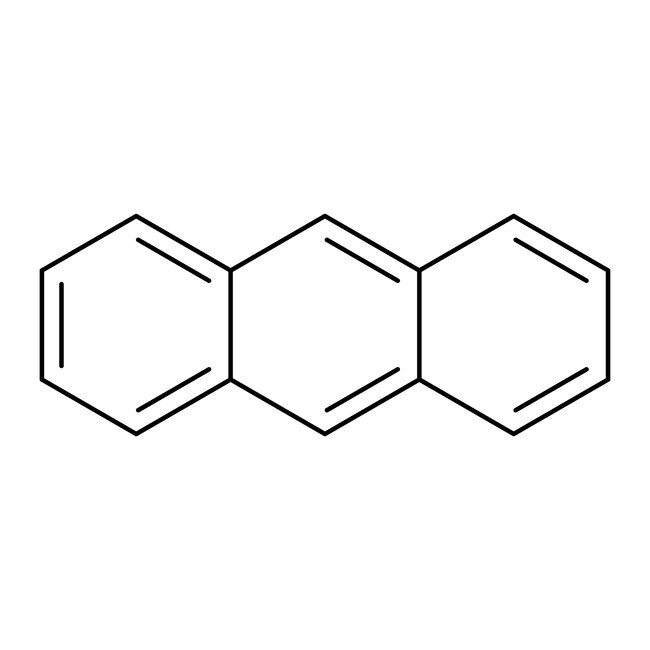Search Thermo Fisher Scientific
Thermo Scientific Chemicals
Anthracene, 97%, Thermo Scientific Chemicals
Catalog number: A17261.0B
1000 g, Each



Thermo Scientific Chemicals
Anthracene, 97%, Thermo Scientific Chemicals
Catalog number: A17261.0B
1000 g, Each
Quantity
Catalog number: A17261.0B
also known as A17261-0B
Price (EUR)
201,60 Online price
224,00
Each
Quantity
-
Chemical Identifiers
CAS
120-12-7
IUPAC Name
anthracene
Molecular Formula
C14H10
InChI Key
MWPLVEDNUUSJAV-UHFFFAOYSA-N
SMILES
C1=CC2=CC3=CC=CC=C3C=C2C=C1
Specifications
Appearance (Color)
Pale cream to cream to yellow to green to pale brown to black
Form
Crystals or powder or crystalline powder
Assay (HPLC)
≥96.0%
Identification (FTIR)
Conforms
Melting Point (clear melt)
213.0-222.0?C
Description
Anthracene is used as a source of dyestuffs and involved in the preparation of red dye alizarin. It is an organic semiconductor used as a scintillator for detectors of high energy photons, electrons and alfa particles. It is doped with polyvinyltoluene to prepare plastic scintillator. Further, it is used in the preparation of anthraquinone, wood preservatives, coating materials and pigments. In addition to this, it is used to prepare 1-hydroxyanthracene, 2-hydroxyanthracene and in 9,10-dihydroxyanthracene.
This Thermo Scientific Chemicals brand product was originally part of the Alfa Aesar product portfolio. Some documentation and label information may refer to the legacy brand. The original Alfa Aesar product / item code or SKU reference has not changed as a part of the brand transition to Thermo Scientific Chemicals.
Applications
Anthracene is used as a source of dyestuffs and involved in the preparation of red dye alizarin. It is an organic semiconductor used as a scintillator for detectors of high energy photons, electrons and alfa particles. It is doped with polyvinyltoluene to prepare plastic scintillator. Further, it is used in the preparation of anthraquinone, wood preservatives, coating materials and pigments. In addition to this, it is used to prepare 1-hydroxyanthracene, 2-hydroxyanthracene and in 9,10-dihydroxyanthracene.
Solubility
Soluble in methanol, benzene, chloroform, ether, carbon disulfide, carbon tetrachloride and toluene. Slightly soluble in acetone. Insoluble in water.
Notes
Light sensitive. Incompatible with strong oxidizing agents and hypochlorites.
Anthracene is used as a source of dyestuffs and involved in the preparation of red dye alizarin. It is an organic semiconductor used as a scintillator for detectors of high energy photons, electrons and alfa particles. It is doped with polyvinyltoluene to prepare plastic scintillator. Further, it is used in the preparation of anthraquinone, wood preservatives, coating materials and pigments. In addition to this, it is used to prepare 1-hydroxyanthracene, 2-hydroxyanthracene and in 9,10-dihydroxyanthracene.
Solubility
Soluble in methanol, benzene, chloroform, ether, carbon disulfide, carbon tetrachloride and toluene. Slightly soluble in acetone. Insoluble in water.
Notes
Light sensitive. Incompatible with strong oxidizing agents and hypochlorites.
RUO – Research Use Only
Figures
Documents & Downloads
Certificates
Search by lot number or partial lot number
Frequently asked questions (FAQs)
Citations & References
Search citations by name, author, journal title or abstract text
Safety and Handling
Classification of the substance or mixture
CLP classification - Regulation(EC) No 1272/2008
Skin Corrosion/Irritation
Category 2
Acute aquatic toxicity
Category 1
Chronic aquatic toxicity
Category 1
Label Elements
Signal Word
Warning
Hazard Statements
H315 - Causes skin irritation
H410 - Very toxic to aquatic life with long lasting effects
EU Specific Hazard Statements
May form combustible dust concentrations in air
Precautionary Statements
P280 - Wear protective gloves/protective clothing
P302 + P352 - IF ON SKIN: Wash with plenty of soap and water
P332 + P313 - If skin irritation occurs: Get medical advice/attention